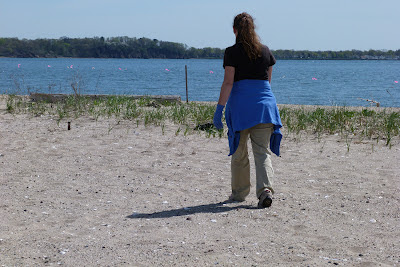This is the sixth update by the Audubon Alliance for Coastal Waterbirds (AAfCW) for the 2012 season. It includes reports of Piping Plover and American Oystercatcher received from 12:00 p.m. on April 16 through 12:00 p.m. on April 23 with sightings of birds spanning April 15 through April 22 by our staff and volunteers.
Survey and monitoring updates:
Piping Plover
Volunteer and staff surveys:
2 pairs, 4 adults at Sandy/Morse Points on 4/15
2 pairs at Sandy/Morse Points on 4/15
3 pairs, 2 adults at Griswold Point on 4/15
3 pairs at Harkness Memorial State Park on 4/16
3 pairs at Bluff Point on 4/16
One 1-egg nest at Sandy/Morse Points on 4/16
4 pairs, 3 adults at Sandy/Morse Points on 4/17
3 pairs, 2 adults at Milford Point on 4/17
3 pairs at Long Beach on 4/17
3 pairs at Harkness Memorial State Park on 4/17
1 pair at East Broadway Milford on 4/18
1 pair, 1 adult at Sandy/Morse Points on 4/18
4 pairs, 1 adult, 1 nest at Sandy/Morse Points on 4/18
7 pairs, one 4-egg nest and one 3-egg nest at Long Beach on 4/19
2 pairs at Sandy/Morse Points on 4/19
2 or 3 pairs at Milford Point on 4/19
5 pairs at Griswold Point on 4/19
3 adults at Bluff Point on 4/20
4 pairs at Bluff Point on 4/20
1 pair at Walnut Beach Milford on 4/21
4 pairs, 1 adult at Long Beach on 4/21
1 pair at East Broadway Milford on 4/21
6 pairs, 1 adult at Long Beach on 4/21
3 pairs at Harkness Memorial State Park on 4/21
8 pairs, two 3-egg nests and one 2-egg nest at Bluff Point State Park on 4/21
American Oystercatcher
Volunteer and staff surveys:
3 pairs at Chimon Island on 4/16
2 pairs, 3 adults at Cockenoe Island on 4/16
2 adults at Calf Pasture Island on 4/16
2 pairs at Sandy/Morse Points on 4/17
4 pairs at Cockenoe Island on 4/17
1 pair at Long Beach Island on 4/17
1 pair at Shea Island on 4/17
2 pairs at Milford Point on 4/17
1 pair with 1 nest (first for CT in 2012) at Sandy/Morse Points on 4/18
2 pairs, 1 nest at Sandy/Morse Points on 4/19
2 pairs at Milford Point on 4/19
2 pairs at Griswold Point on 4/19
1 pair at Bluff Point on 4/20
1 pair at Pleasure Beach on 4/21
2 pairs at Griswold Point, 1 pair with one individual banded with a yellow “W8” band seen flying west with mate on 4/22
4 pairs at Menunketesuck Island on 4/22
4 pairs at Duck Island on 4/22
There have been no reports of Least Tern or Common Tern though this may change by the next update. A Caspian Tern was noted by a trusted observer at Sandy/Morse Points on April 21. A passive and cautious distant survey of some of the Norwalk Islands yielded (in lower than actual numbers) at least 160 Great Egret, most in two colonies on Cockenoe Island, and about 20 Snowy Egret. At least several dozen of both species are also on Charles Island. Several Black-crowned Night-Heron were spotted on the Norwalk Islands and many more are being seen in and around Charles Island. At least 16 were noted on Duck Island along with numbers of Great Egret on both Duck and Menunketesuck Islands. Yellow-crowned Night-Heron have been reported more frequently from Fairfield through New Haven with many nesting reports.
Little Blue Heron sightings dropped in the last week, though Glossy Ibis were almost common in expected areas, with groups numbering from several to over 20 seen repeatedly. A White-faced Ibis, which may have been in Stratford on 4/18 based on a photograph, was a found in Guilford on 4/19.
Semipalmated Sandpiper, Least Sandpiper, and Semipalmated Plover have both been spotted a few more times in Milford and now Stratford. Black-bellied Plover are becoming common along the coastline as Dunlin and Sanderling are increasing. Two Purple Sandpiper were seen around the Norwalk Islands on 4/17. Willet are now common in expected areas in low to moderate numbers. The significant coastal low and heavy rainfall in the early week may lead to more shorebirds having been “downed” by the conditions or rarities and vagrants brought to Connecticut, and all observers should keep an open mind.
This concludes update #6 through 4/23/12 as of 4:00 p.m.
Audubon Alliance for Coastal Waterbirds, Audubon Connecticut and the Connecticut Audubon Society partnering to improve conditions for coastal waterbirds in Connecticut.























































